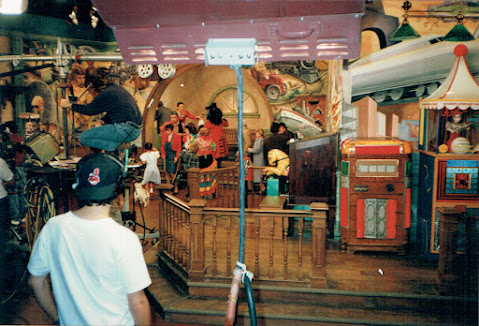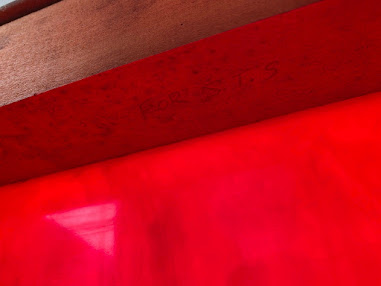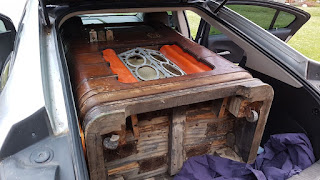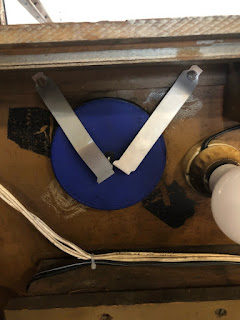The STS Jukebox
"Where dreams can come true..."
 |
| Set photos: Rick Siggelkow |
The world of Shining Time Station always felt safe to me. I remember spending countless hours wondering about the sets from the show. I would dream about being on set, under the lights, chatting with the actors... I never thought a piece of that would somehow be recoverable.
 |
It took several months of pursuing, convincing, driving, funding, scrutinizing, and a whole lot of blood, sweat, and tears. And here we are.
Many of you asked about how the story unfolded. Here it is.
In late September of 2020, I was mindlessly Google image searching STS and I stumbled upon a Twitter post with a screencap of an Instagram post. A fellow in Ontario (who will remain unnamed and be hereon referred to as “the fellow”) stated that he believed that the jukebox he had purchased for a project was in fact the very prop from STS.
I could not believe it. My heart stopped.
I immediately hopped on Instagram, commenting and DM’ing the fellow as quickly as I could. No response. Not even a like on my comment. Several others had commented on the post, and I could gather that it had been confirmed that it was the actual prop. No reply to my DM. I must have gone on Instagram every day for several weeks but I could see that he had not even read it. I was pretty disheartened.
I began to follow this fellow on Instagram and ended up commenting on more recent posts, asking him for the current state of the jukebox project. Eventually, he replied. He said he had not made up his mind whether he was going to restore and sell it or keep it for his own personal project. He also said that he had many other projects ahead of it in the queue. So, I had to be patient.
Eventually, after several months of more casual comments, I decided I needed to be more direct. Near the end of May 2021, I asked him if he would sell it to me. I even made him a cash offer on Instagram and publicly posted my phone number (insane!) He stated that he was pretty set on using it for another project he had in mind – which he would begin soon – that involved him heavily modifying it and using it as a record player for his many singles. I was, of course, mortified. He stated that he had no attachment to the show, other than thinking it was a nice collector’s piece. He also loved the chrome music notes on the sides, a rare component of the English Gerber & Glass light-up kits.
A couple of days later, I’m eating my fish and chips dinner when I get a call from a random number. I had a thought that it might be a pesky telemarketer but I had a strange feeling. It was the jukebox man. He said that he’d read my comment and decided to get in touch. He said that the piece looked much different than I thought it might and there was a lot of work required. He was a week or two away from finally beginning work on it, cutting it up for his own project. Apparently, it was just the right size for his project and he wasn’t sure he’d be able to find another jukebox big enough to fit his 200-capacity record changer.
All I heard were possibilities. He called. He connected. Now was my chance. I can talk to people! I can convey emotion! I do it for a living, after all.
I shared with him my connection to Shining Time. I told him about my grandmother, who taped almost every single episode on 6 VHS tapes for me starting from when I was about 4 years old. This show was in my blood. It was an emotional connection – this really appealed to him. He had emotional attachments to his antiques that he had lovingly restored. He said I was tugging at his heartstrings.
At the end of the phone call, he stated that he would give me the first option to buy it should he decide to sell. He had to talk it over with his wife and think about it. I made my final (higher) offer to convey my seriousness and my commitment to the project. Included in that offer was the agreement that he would restore the jukebox (I simply did not have the skills, resources, nor money to fund that kind of work).
I heard from him the next night. He had agreed. The one contingent was that I come out to see it in person before the deal was final, so that I knew what I was working with. Naturally, I freaked out. It was 5 days before my birthday. 5 is my lucky number. Could there be anything better?
That night, he sent me this photo of the jukebox rear, evidencing its life as a prop, as well as the photo below some days later to show what it looked like illuminated (by flood light).
I told my good friends on Twitter about it. One of them agreed to drive me about an hour west of Toronto to see it a few weeks later. Here’s a picture of me that the fellow snapped before I left. In the words of Rick Siggelkow, it looked a little “worse for wear” at the time but I was elated. Talking over all the details, we finalized the project that day on June 3, 2021.
I was hoping it would be done over the summer but that depended on a lot of factors: the pace of the restoration work, finding jukebox components that had been lost/misplaced/broken since the show wrapped… but I remained hopeful. The hardest part was over and I was committed.
Back to her former glory
Restoration is not for the faint of heart. As incredibly grateful as I am for the opportunity to restore a piece of TV history, it is many things: it is painstaking and expensive. It requires good communication. It is a perfectionist's nightmare. It involves countless hours of poring over photos, ensuring you get every detail as screen accurate as possible.
The latter was very difficult in the context of STS as any fans of the show know that most of the YouTube uploads are pretty poor quality (although this is improving thanks to the dedication of fans). I began by making a massive folder of screen caps from every single episode of the show. Every shot of the jukebox, at every angle, in every kind of lighting so that we could figure out exactly how they crafted the prop. We realized pretty early on that the prop was thrown together pretty quickly (as evidenced by the duct tape marks inside - see interior below). It also became clear that, contrary to popular belief, the jukebox actually underwent several cosmetic changes throughout the show’s run. I opted to replicate it as close as possible to its last on-screen appearance in the Family Specials. This meant that the song selector hole that contained the remains of its song selector mechanism in Season 1 would have its black knob as per the later seasons, and the board framing the title board would be beige as opposed to its Season 1 grey. It’s all in the details 😉
It should be noted, I did consider making the jukebox operational as I had the opportunity to do. However, I decided against it to remain true to the prop. It would have significantly changed the inward and outward appearance of the prop, which I wasn't willing to do (and the little bluetooth speaker I have behind the grille works wonders!)
It was touching to see the fellow’s excitement about the project early on. I would send him a shot of Ringo Starr as Mr. Conductor standing in front of the jukebox – to show some of the unique imperfections in the wood veneer – and he would send me a photo back matching the same marks on the actual jukebox (see below). Not only did it verify that it was “the real deal” as he would say, it was also fun detective work. During our first meeting, he talked of his plans to re-polish the coloured plastic, resurface the metal components, and sand down and refinish the wood veneer – NO, I said. I wanted to preserve all the jukebox’s unique marks from its life as a TV prop and from before, when it was sitting in some jukebox dive playing tunes from the 1930s.
Here’s another detail that he found, on an inside wood ledge under one of the top pieces of red plastic. God bless the durability of pencil. He was almost giddy showing us this tiny detail he had luckily spotted.
Restoration officially begins
I will still never forget the feeling of seeing the first few photos of the work underway 😊
He began by removing most of the jukebox’s components, stripping it down to its basic wood structure. It was then given several coats of matte varnish to help preserve the wood and prevent it from rotting (see below). He had also already begun to repair some of the chips in the wood veneer as it was missing several pieces. He did this by cutting spare veneer he had down to the right size and carefully gluing it in. He also had to varnish the new pieces to colour-match the existing wood.
On my end, I had been scouring online auctions and classified for the missing jukebox parts. For those who are not aware, this jukebox is the shell of a 1937 Wurlitzer 616 – one of the last all-wood Wurlitzers! It was designed by the well-known Paul Fuller, the man behind many of the classic Wurlitzer designs of the 1930s and 1940s. Unfortunately, the STS jukebox in its then-state was missing several things: its original coin slides and bezel, the entire title board assembly, and the black knob to cover the song selector hole, not to mention several pieces of red side and grille plastic as the originals were cracked and light damaged beyond repair.
I soon saw an ad for a complete Wurlitzer 616A which was exactly what we were looking for for parts. Another investment but worth it in the long run given that it could take several months or more to find the specific parts we were looking for (which were even more costly to purchase individually). After consulting with the fellow, I decided to purchase it for the project. My friend helped drive me to deep Scarborough to pick up this “donor juke” (below) and we made our second trip out west to drop it off on June 11 – also getting the opportunity to see the newly varnished “STS”, as the fellow dubbed our jukebox.
Interestingly, the man I purchased the 616A donor juke from was actually the original owner of the STS jukebox (although he couldn’t really recall it). He had obtained it from the CBC Props Department, likely through auction sometime in 2007 after the Props Department was officially closed down on May 31 of that year. Thank god our beloved juke made it safely out, avoiding a fate that was predicted in the one of the show’s Family Specials:
Before my fellow bought it off this man, he had sadly stripped the juke of some of her more valuable aforementioned components and those are now feared lost for good. At least a donor was found. For those interested, here's a link to an article on the closure of the CBC Props Department that led to the jukebox's auction:
Side note: the donor 616A was extremely heavy. And it fit in the trunk of a Chevy Volt (I was as surprised as you are).
The right look
Next, he could continue the work on the cosmetics of the prop. He polished the original plastic and chrome pieces, putting them back in. He also cleaned and polished the coin slides from the donor juke, returning them to their happy home in “STS”. What a thrill to see those added (I could just see Schemer pushing a nickel in with a flick of his hip!) He then added the red-orange phenolic plastic pieces inside the grille. The originals were warped and cracked beyond repair. He took the plastic from the donor juke, melted it (very carefully) in an oven to return it to a flat state, and flipped them around the other direction to display the cleaner unmarked side (genius!) He reattached the die-cast grille pieces and polished all of the screws, also replacing several that were used to screw in the chrome pieces surrounding the coloured plastic.
He also began work mocking up the black plastic knob to go over the song selector hole. In the original Wurlitzer, this was covered by a beautiful bezel containing buttons to select 1 of 16 records, as seen here:
The black knob underwent a couple of attempts as the first one he made was too big and did not protrude enough from the hole. More hours of back-and-forth and looking at blurry screenshots… but we got there. He ended up using several lids screwed together, spray glued and covered in turntable flocking. This was all held in place with stainless steel springs – not duct tape like the original!
He also made a custom basket inside the jukebox (below) to catch the coins falling from the coin slides. In the original operating machine, these would have travelled down a metal coin chute into a secure lockbox (which, unfortunately for Schemer, would have always been empty due to Tito's thirsty appetite for nickels..) None of these pieces would have existed inside the original prop however as it has been confirmed by crew that it was mostly gutted and only illuminated for filming. Any coins that were inserted by the cast would have simply fallen into the jukebox interior (unless they also had a similar contraption).
Lighting was another tricky piece. If you look carefully at clips of the show, the jukebox was lit differently in different seasons: in Season 1, they lit the red side panels and front grille whereas in Seasons 2 and 3, they did not and the top lighting was much more prominent. We opted to go for a good general lighting that was not too harsh but warm and consistent. The only sockets that remained in the jukebox in its purchased state were the middle center socket to light the coin slides and the 6 sockets in the front grille assembly. The wires were extremely old and frayed so he completely rewired these areas with new wiring. Then, toward the end of restoration, he spent an entire day (9 hours straight) rewiring the interior: 15 new sockets in total. We then outfitted it with 21 LED appliance bulbs, one full-size bright LED bulb in the middle center socket, and a small regular 7W bulb in the center of the middle yellow panel to help illuminate it evenly. Phew! Fortunately, the LEDs mean longevity and much less heat stress on the old plastic. Did I mention how grateful I am that he’s an electrical engineer?
The Finishing Touches
Another difficult piece to track down was the elusive title board, which is not actually from a Wurlitzer 616 but from a 750/780. They are quite rare. Luckily, things in this project just seemed to come together. In June, one appeared on eBay. I joined a fierce bidding contest and won it by all of $10. It flew to us all the way from California! He then custom cut 24 pieces of card for the song titles (which we opted to leave blank for imagination's sake, and as there is no clear shot of all of them in the show). He then constructed the border for the title board out of two pieces of press board (below) painted beige. Let me just say, getting that colour right was one of the trickiest parts of the project. Hours of looking at photos and footage, as well as a multitude of paint samples (eventually landing on the ever-reliable TRUSTY TAN). The title board looked different in every type of lighting! We ended up landing on something that captures the feeling of the original while still keeping it fairly neutral. He then assembled the title board and its border, screwing it into the rear of the glass jukebox door (in the original, the 16-record player would have been visible through the door). Again, I wanted a more permanent solution than duct tape (yes, they taped this on too as evidenced by the marks on the inside wood).
Without and with the final title board assembly:
He even custom made a tiny key to help open the glass door (as the original had long been lost). The amount of care he put into this project… look at that wee key 🥺
The last piece of the puzzle was the red side plastic that, unfortunately, was broken beyond repair. The fellow glued together the most intact red panel which was then sent to another man who specializes in making custom plastic. My fellow had wanted to do the plastic himself but did not have an oven large enough to melt and bend the plastic into shape. He picked a red colour that was as close as possible to the original (unfortunately, we could not replicate the swirls in the original Catalin plastic but it is hardly noticeable). The plastic was then custom-made according to the original panel, bent into shape, with holes drilled for the screws that hold it in place. In the end, it really did the trick!
The most exciting moment of this whole endeavour finally arrived on July 19 when he sent me the above photos of the completed jukebox. What a beauty! I was absolutely thrilled with his work on the lighting and title board, in particular. One of the last modifications was a repaint of the custom rear door he had made for the jukebox (so that the light wouldn’t shine onto the wall when illuminated) – from beige to black. With that, it was a wrap! From start to finish, the whole project took about 3 months to complete. Record time when you consider all the work that went into it and the luck with finding the rare parts. Here is a diagram of the major points of the restoration:
Coming home
My friends and I went to pick up the finished jukebox on August 6, 2021. This was no easy feat. She fit (just barely) in the Chevy Volt trunk, but it was a bit of a nervous drive back to Toronto as we were so worried about keeping her safe. When we finally arrived at my place, we carefully lifted her from the trunk and the three of us carried her up nearly four flights of stairs – not a job for the faint of heart! “Be careful”, the fellow had said. “That plastic is extremely old and fragile” (not to mention nearly irreplaceable). But we made it! Here is a picture of the final reunion:
I then revealed the jukebox online later that night when we had settled in. You can’t imagine how excited I was to share it with you all! No matter how special this project was to me or how excited I was to have this piece of history in my home, it’s all a little worthless unless you have people to share it with. The fact that you were all so excited really made it special. At the end of the day, it’s all about human connection.
Again, I could not have done this without my friends. Thank you for the drives, the long calls, for reassuring me when I was anxious about something – honestly, I could not have actually accomplished this had it not been for your support. I am so grateful to be able to preserve this prop for generations to come. It’s not just for me – it’s for everyone✨
Also, a huge shoutout to the talented fellow who agreed to sell this beauty to me and restore it lovingly back to its former glory. Thank you, truly.
Lastly, as someone who believed the STS props were lost to time:
“Nothing is impossible, unless you stop believing in it.”
PS. To the Jukebox Band: Fear not. Your home has been saved 💖
















































TITO: Feast your eyes fellow music folk.
ReplyDeleteGRACE: Looks like home.
DIDI: Home sweet musical home.
TEX: Looky Rex, our corral is back.
REX: To misquote Miss Didi, Home on the Range.
BOTH: The Home Ranger.
JJ: Play a tune. They'll owe us a nickel!
Welcome back, guys💖
DeleteWhat would the different versions of Shining Time Station look like if they were set in Great Britain, Ireland, Canada, Australia & New Zealand with fictional versions of defunct railways & different names?
ReplyDelete